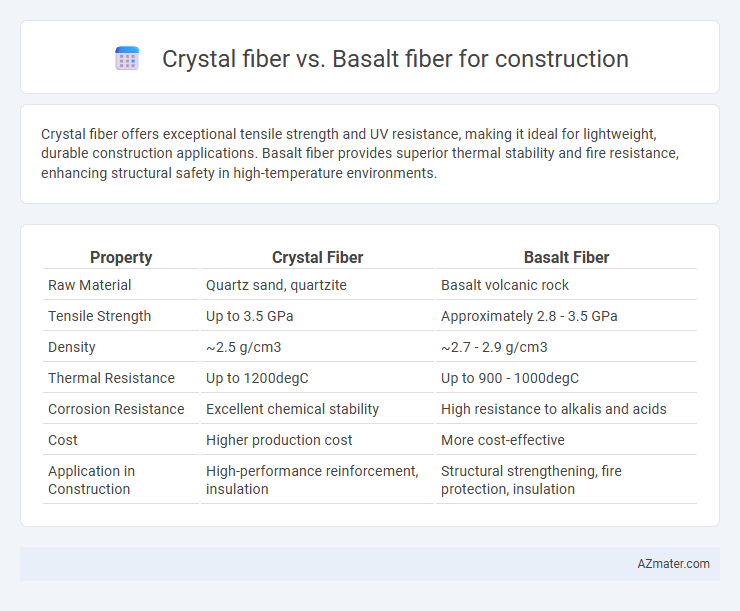Crystal fiber offers exceptional tensile strength and UV resistance, making it ideal for lightweight, durable construction applications. Basalt fiber provides superior thermal stability and fire resistance, enhancing structural safety in high-temperature environments.
Table of Comparison
| Property | Crystal Fiber | Basalt Fiber |
|---|---|---|
| Raw Material | Quartz sand, quartzite | Basalt volcanic rock |
| Tensile Strength | Up to 3.5 GPa | Approximately 2.8 - 3.5 GPa |
| Density | ~2.5 g/cm3 | ~2.7 - 2.9 g/cm3 |
| Thermal Resistance | Up to 1200degC | Up to 900 - 1000degC |
| Corrosion Resistance | Excellent chemical stability | High resistance to alkalis and acids |
| Cost | Higher production cost | More cost-effective |
| Application in Construction | High-performance reinforcement, insulation | Structural strengthening, fire protection, insulation |
Introduction to Crystal Fiber and Basalt Fiber
Crystal fiber, known for its high tensile strength and chemical resistance, is a synthetic fiber derived from pure quartz and used extensively in reinforcing concrete and composites. Basalt fiber, produced from volcanic rock and characterized by excellent thermal stability and environmental durability, serves as an eco-friendly alternative to traditional fibers like glass and carbon in construction applications. Both fibers enhance structural performance but differ significantly in raw material sources and specific mechanical properties suitable for construction reinforcement.
Composition and Manufacturing Processes
Crystal fiber, primarily composed of silica glass, is manufactured through a melt-drawing process that results in fine, continuous filaments with high tensile strength and excellent thermal resistance. Basalt fiber, derived from natural volcanic basalt rock, undergoes melting and extrusion without additives, producing fibers that excel in chemical durability and fire resistance. The fundamental difference in raw material composition and manufacturing techniques directly influences their mechanical properties and suitability for various construction applications.
Mechanical Properties Comparison
Crystal fiber exhibits higher tensile strength and elastic modulus compared to basalt fiber, making it suitable for load-bearing structural applications. Basalt fiber offers superior impact resistance and better thermal stability, enhancing durability under varying environmental conditions. Both fibers provide corrosion resistance, but crystal fiber's mechanical consistency under stress contributes to longer service life in construction projects.
Durability and Longevity in Construction
Crystal fiber exhibits excellent resistance to corrosion, chemical attacks, and high temperatures, making it highly durable in harsh construction environments. Basalt fiber offers superior mechanical strength and outstanding resistance to UV radiation and alkalinity, contributing to its long lifespan in structural applications. Both fibers enhance the longevity of construction materials by providing superior durability compared to traditional fibers like glass or carbon.
Thermal Performance and Insulation
Crystal fiber exhibits superior thermal performance with low thermal conductivity, making it highly effective for insulation in construction applications where heat resistance is crucial. Basalt fiber also provides excellent insulation properties but offers slightly higher thermal conductivity compared to crystal fiber, which may impact its effectiveness in extreme temperature environments. Both fibers enhance energy efficiency in buildings, but crystal fiber's enhanced heat insulation makes it a preferred choice for advanced thermal management.
Chemical Resistance and Environmental Impact
Crystal fiber exhibits superior chemical resistance compared to basalt fiber, particularly against acids, alkalis, and solvents, making it ideal for harsh construction environments exposed to corrosive substances. Basalt fiber offers moderate chemical resistance but is more biodegradable and environmentally friendly, derived from natural volcanic rock with lower energy consumption in production. The low environmental impact of basalt fiber aligns well with sustainable construction practices, whereas crystal fiber's performance outweighs its higher ecological footprint in applications demanding exceptional durability.
Weight and Structural Efficiency
Crystal fiber offers a high strength-to-weight ratio, making it significantly lighter than basalt fiber while maintaining excellent tensile strength for construction applications. Basalt fiber, though heavier, provides enhanced durability and thermal resistance, contributing to improved structural integrity in demanding environments. Choosing crystal fiber maximizes structural efficiency through lightweight reinforcement, whereas basalt fiber prioritizes robustness under thermal and mechanical stress.
Cost Analysis and Economic Considerations
Crystal fiber offers high tensile strength and durability but comes at a higher initial cost compared to basalt fiber, which is more economically viable due to its lower production expenses and abundant raw materials. Basalt fiber provides a cost-effective alternative with competitive mechanical properties, making it suitable for large-scale construction projects aiming to optimize budget without compromising performance. Evaluating life-cycle costs reveals that basalt fiber often results in reduced maintenance expenses and better overall economic efficiency in structural applications.
Applications in Modern Construction Projects
Crystal fiber offers exceptional tensile strength and durability, making it ideal for reinforcing concrete structures in high-rise buildings and bridges. Basalt fiber provides superior thermal resistance and corrosion protection, which enhances its application in harsh environments such as tunnels and marine construction. Both fibers contribute to lightweight, sustainable building materials that improve structural integrity and longevity in modern construction projects.
Future Trends and Innovations in Fiber Technology
Crystal fiber and basalt fiber are emerging as advanced materials in construction due to their superior strength, durability, and resistance to extreme conditions. Future trends emphasize the integration of nanotechnology and enhanced composite formulations to improve their mechanical properties and thermal stability, enabling more sustainable and resilient infrastructure. Innovations also target cost reduction and scalability, positioning these fibers as competitive alternatives to traditional steel and synthetic fibers in modern construction projects.

Infographic: Crystal fiber vs Basalt fiber for Construction
 azmater.com
azmater.com